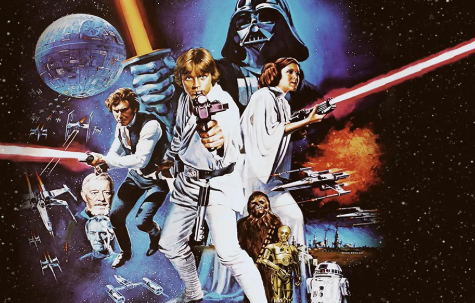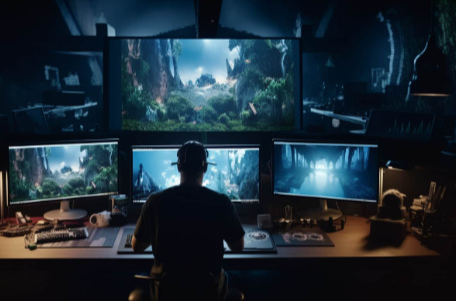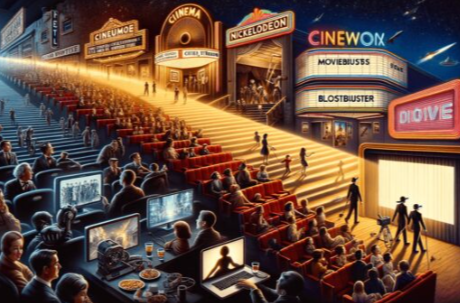Top Movie Genres Explained: What Makes Each One Unique?

The world of cinema is rich with diverse genres, each offering distinct narratives and emotional experiences. From the adrenaline-pumping sequences of action films to the introspective journeys found in dramas, these categories shape audience engagement in unique ways. Comedies provide levity, while horror films explore our deepest fears. This exploration raises questions about the underlying elements that define these genres. What truly sets them apart, and how do they resonate differently with viewers?
Action: The Heart-Pounding Thrills
Action films frequently captivate audiences with their relentless pace and exhilarating sequences, serving as a quintessential genre in cinema. Central to this genre are choreographed stunts, meticulously crafted to evoke a visceral response, drawing viewers into a whirlwind of adrenaline-pumping excitement.
These sequences not only showcase physical prowess but also embody the essence of freedom, allowing characters to transcend ordinary limits. The thrill derived from high-octane car chases, explosive confrontations, and daring escapes underscores a universal desire for liberation and adventure.
Furthermore, the genre often reflects societal tensions, using action as a metaphor for struggle against oppression. In its finest moments, action cinema becomes a celebration of resilience, inviting audiences to embrace the exhilarating chaos of life itself.
Read more: Behind the Scenes: How Movies Are Made From Script to Screen
Comedy: Laughter as the Best Medicine
While many genres aim to evoke strong emotions, comedy uniquely thrives on the ability to generate laughter, serving as a vital antidote to the stresses of everyday life.
This genre encompasses a diverse array of styles, from the physicality of slapstick humor to the cleverness of witty dialogue. Slapstick, with its exaggerated actions and visual gags, offers a visceral form of humor that transcends language barriers, appealing to a broad audience.
Conversely, witty dialogue engages viewers intellectually, often delivering sharp observations about societal norms and human behavior.
Drama: Exploring the Depths of Human Emotion
Emotion lies at the heart of drama, serving as a powerful conduit for audiences to connect with the intricacies of the human experience. This genre excels in character development, crafting multifaceted individuals whose journeys evoke empathy and reflection.
Through nuanced performances and compelling narratives, dramas explore the depths of human emotion, revealing the complexities of love, loss, and resilience. The emotional resonance achieved in these films often transcends mere entertainment, prompting viewers to confront their own feelings and experiences.
Horror: Fear and the Supernatural
Horror, as a genre, masterfully taps into primal fears and the unknown, creating an atmosphere that unsettles and captivates audiences. It often intertwines psychological thrillers with supernatural elements, crafting narratives that challenge perceptions of reality.
The genre exploits innate anxieties, provoking a visceral response that reflects societal fears and personal insecurities. By utilizing suspense and unpredictability, horror films elicit both dread and curiosity, compelling viewers to confront their darkest thoughts.
Supernatural elements, such as ghosts or demons, serve as metaphors for unaddressed emotions and moral dilemmas, further enriching the experience. Ultimately, horror not only entertains but also provides a space for exploration of fear, making it a unique and powerful form of storytelling that resonates deeply with the human experience.
Romance: Love Stories That Captivate
Romance films offer a counterbalance to the tension and fear often explored in horror, inviting audiences to engage with the complexities of love and human connection.
These narratives frequently explore themes of unrequited love, allowing viewers to empathize with the heartache and yearning that accompany such experiences. Romantic tropes, such as the chance encounter or the love triangle, serve to heighten emotional stakes and draw audiences into the protagonists’ journeys.
These films not only celebrate love’s triumphs but also delve into the challenges it presents, reflecting the multifaceted nature of relationships.
Ultimately, romance films resonate with those seeking an exploration of passion and vulnerability, providing an essential lens through which the human experience is both understood and cherished.
Science Fiction: Imagining the Future
Science fiction serves as a lens through which audiences can explore the potential impacts of futuristic technology on society.
By presenting imaginative advancements, these films often provoke thought on ethical dilemmas and societal structures that may emerge alongside such innovations.
This genre invites viewers to reflect on humanity’s trajectory, questioning not only what is possible but also what it means for the future of civilization.
Futuristic Technology Portrayals
Although often rooted in contemporary societal issues, futuristic technology portrayals in science fiction offer a lens through which audiences can explore the potential consequences of innovation.
These narratives frequently feature futuristic gadgets that enhance human capabilities, raising questions about AI ethics and the implications of advanced robotics. The depiction of virtual realities invites viewers to consider the blurred lines between existence and simulation, while tech dystopias serve as cautionary tales of unchecked technological advancement.
Additionally, themes of space exploration and the promise of nanotechnology advancements inspire hope for humanity’s future. Cybernetic enhancements challenge traditional notions of identity, compelling audiences to reflect on the balance between human essence and technological integration in an increasingly complex world.
Societal Implications Explored
While examining the narratives within science fiction, it becomes evident that these stories serve as a mirror reflecting societal anxieties, aspirations, and ethical dilemmas.
Science fiction often functions as profound social commentary, critiquing contemporary issues through imaginative scenarios. By envisioning alternate realities, filmmakers explore the implications of technological advancements, environmental degradation, and social inequality, prompting audiences to question the direction of their own society.
Furthermore, the genre acts as a cultural reflection, revealing collective hopes for the future while grappling with fears of dystopia. In doing so, science fiction not only entertains but also invites critical discourse, urging viewers to engage with pressing moral and philosophical questions.
This dual role underscores the genre’s significance in shaping societal perspectives.
Fantasy: Escaping Into Other Worlds
The fantasy genre captivates audiences through its rich tapestry of magical elements and fantastical creatures, inviting viewers to escape the confines of reality.
Central to this genre is the intricately constructed world-building and lore that provide a backdrop for extraordinary adventures. Such elements not only enhance the narrative but also foster a deep emotional connection, allowing audiences to explore the limitless possibilities of imagination.
Magical Elements and Creatures
In the realm of fantasy cinema, magical elements and creatures serve as gateways to otherworldly experiences, captivating audiences with their boundless imagination.
These narratives often intertwine magical realism with the extraordinary, allowing viewers to explore the limits of reality.
Mythical creatures—such as dragons, fairies, and wizards—embody the essence of the fantastical, representing humanity’s deepest desires and fears.
They challenge the mundane, inviting audiences to transcend their everyday lives and embrace the extraordinary.
The presence of these beings enriches the narrative, fostering a sense of wonder and exploration.
Ultimately, magical elements and creatures are not merely escapist tools; they reflect profound themes of transformation, identity, and the perpetual quest for freedom within the realms of possibility.
World-Building and Lore
Magical elements and creatures often serve as the foundation upon which intricate worlds are built, imbuing fantasy narratives with depth and richness.
Effective world-building techniques involve creating cohesive rules and histories that define these realms, allowing audiences to immerse themselves in the fantastical. Lore integration plays a crucial role, weaving backstories and mythologies seamlessly into the narrative, enriching character motivations and conflicts.
This intricate tapestry not only enhances the viewer’s experience but also invites them to explore the moral complexities of these alternate realities. Through well-crafted settings, fantasies provide an escape from the mundane, tapping into a collective desire for freedom and adventure.
Ultimately, the fusion of world-building and lore creates a compelling landscape that captivates and inspires.
Documentary: Real Stories, Real Impact
While many film genres rely on fiction to engage audiences, documentaries stand out by presenting real stories that resonate with viewers on a profound level.
These films serve as powerful vessels for real life narratives, revealing the complexities of human experiences and societal issues. Through meticulous research and storytelling, documentaries illuminate underrepresented perspectives, fostering empathy and understanding.
Their unique ability to evoke emotional responses often drives social impact, motivating viewers to reflect on their beliefs and take action. By merging factual content with compelling visuals, documentaries challenge audiences to confront reality, stirring a desire for change.
Thus, they not only inform but also empower, reinforcing the notion that authentic stories can inspire profound transformations in society.
Animation: Artistry and Storytelling Combined
Animation transcends mere entertainment by blending artistry and storytelling in a unique manner that captivates diverse audiences. This genre employs striking visual aesthetics to create immersive worlds that resonate emotionally with viewers.
The meticulous craftsmanship involved in animation allows for an expansive range of expressions, often pushing the boundaries of imagination. Character development in animated films is particularly noteworthy; characters can embody exaggerated traits that amplify their narratives, offering profound insights into the human experience.
Through this interplay of art and narrative, animation not only entertains but also invites reflection, challenging societal norms and exploring complex themes. Ultimately, animation stands as a powerful medium, enabling storytellers to convey messages that resonate on both personal and universal levels.
Conclusion
In the kaleidoscopic realm of cinema, each genre unfurls its own tapestry of human experience, weaving together threads of emotion, imagination, and reality. From the adrenaline-fueled escapades of action films to the poignant reflections of documentaries, these diverse narratives illuminate the multifaceted nature of storytelling. As audiences traverse this vibrant landscape, they not only find entertainment but also a mirror reflecting their own lives, fears, and aspirations, enriching their understanding of the world and themselves.



